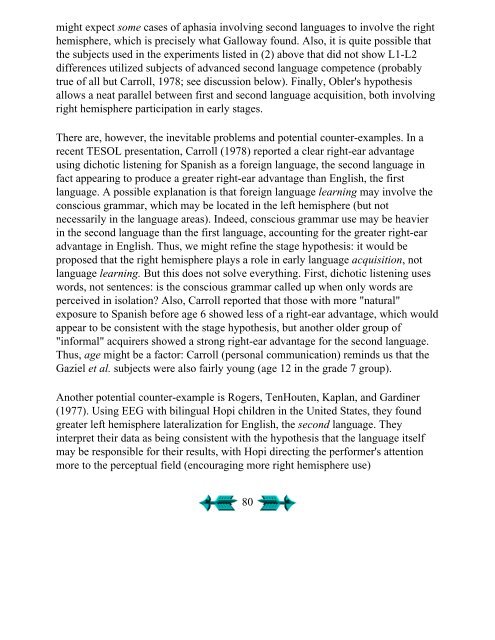Second Language Acquisition and Second ... - Stephen Krashen
Second Language Acquisition and Second ... - Stephen Krashen
Second Language Acquisition and Second ... - Stephen Krashen
You also want an ePaper? Increase the reach of your titles
YUMPU automatically turns print PDFs into web optimized ePapers that Google loves.
might expect some cases of aphasia involving second languages to involve the right<br />
hemisphere, which is precisely what Galloway found. Also, it is quite possible that<br />
the subjects used in the experiments listed in (2) above that did not show L1-L2<br />
differences utilized subjects of advanced second language competence (probably<br />
true of all but Carroll, 1978; see discussion below). Finally, Obler's hypothesis<br />
allows a neat parallel between first <strong>and</strong> second language acquisition, both involving<br />
right hemisphere participation in early stages.<br />
There are, however, the inevitable problems <strong>and</strong> potential counter-examples. In a<br />
recent TESOL presentation, Carroll (1978) reported a clear right-ear advantage<br />
using dichotic listening for Spanish as a foreign language, the second language in<br />
fact appearing to produce a greater right-ear advantage than English, the first<br />
language. A possible explanation is that foreign language learning may involve the<br />
conscious grammar, which may be located in the left hemisphere (but not<br />
necessarily in the language areas). Indeed, conscious grammar use may be heavier<br />
in the second language than the first language, accounting for the greater right-ear<br />
advantage in English. Thus, we might refine the stage hypothesis: it would be<br />
proposed that the right hemisphere plays a role in early language acquisition, not<br />
language learning. But this does not solve everything. First, dichotic listening uses<br />
words, not sentences: is the conscious grammar called up when only words are<br />
perceived in isolation? Also, Carroll reported that those with more "natural"<br />
exposure to Spanish before age 6 showed less of a right-ear advantage, which would<br />
appear to be consistent with the stage hypothesis, but another older group of<br />
"informal" acquirers showed a strong right-ear advantage for the second language.<br />
Thus, age might be a factor: Carroll (personal communication) reminds us that the<br />
Gaziel et al. subjects were also fairly young (age 12 in the grade 7 group).<br />
Another potential counter-example is Rogers, TenHouten, Kaplan, <strong>and</strong> Gardiner<br />
(1977). Using EEG with bilingual Hopi children in the United States, they found<br />
greater left hemisphere lateralization for English, the second language. They<br />
interpret their data as being consistent with the hypothesis that the language itself<br />
may be responsible for their results, with Hopi directing the performer's attention<br />
more to the perceptual field (encouraging more right hemisphere use)<br />
80











